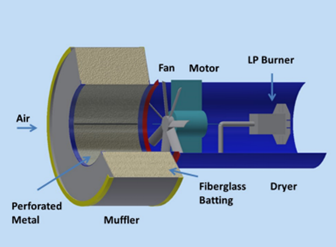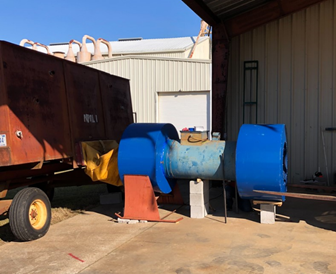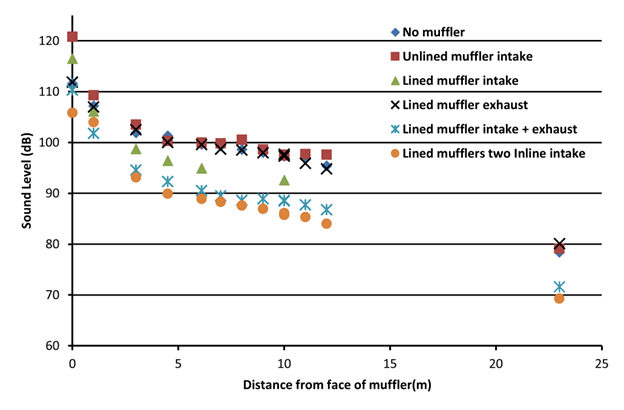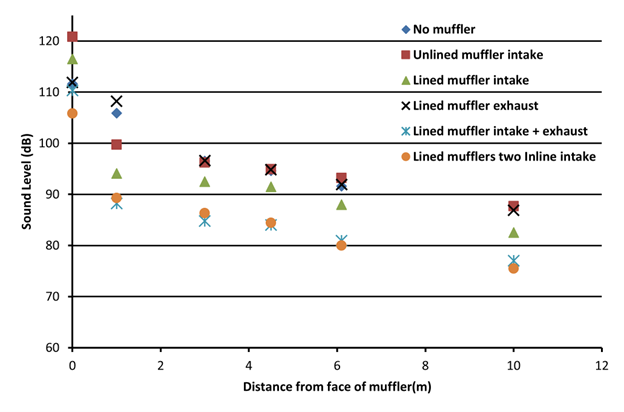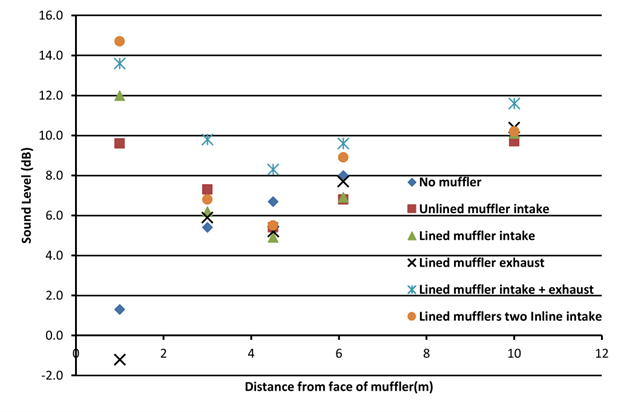Introduction
Harvested peanuts before being stored must be dried to reduce moisture levels to prevent spoilage. Peanuts are dried using forced heated air from a dryer that contains a fan, motor, and a heater or gas burner, all of which produce noise. The problem is that peanut dryers when operating produce a great deal of noise like other crop drying equipment. Noise levels produced by operating crop drying equipment have caused concern since the 1970’s about occupational safety of workers and as sources of nuisance noise. Several studies were conducted in the 1970’s about noise levels from agricultural equipment that used fans. One of the first studies was conducted by Curry and Weber who investigated noise levels produced by radiator axial-flow fans used to cool tractor motors (Curry and Weber, 1972). Ige and Finner studied both axial-flow and centrifugal fans in crop drying equipment (Ige and Finner, 1974). Another investigator, Holger only studied centrifugal fans in crop dryers, but Ige and Finner found that axial-flow fans were the fans that produced noise levels of greatest concern, so they limited their investigation of noise reduction to axial-flow fans (Holger, 1978). Ige and Finner found that a cylindrical muffler lined with 10.2 cm (4 in) of fiberglass could reduce noise levels of an operating dryer to acceptable levels (Ige and Finner, 1974). Woodward studied noise abatement of various configurations of cylindrical mufflers lined with fiberglass that were attached to a vane-axial fan-burner peanut drying unit (Woodward, 1976). He also found that mufflers could abate peanut dryer noise to acceptable levels. However, he conducted his investigation with the peanut dryer being operated in an open grassed area, where normally drying is conducted in an open shed to protect the dryer and drying peanuts from possible rain and settling dew. Drying peanuts in an open shed intensifies noise levels compared to drying in an open grassed area.
Though there was concern in the 1970’s about excessive noise and there were commercially available noise abatement mufflers for crop dryers at the time, there was no compelling reason for agricultural producers to invest in noise abatement equipment. Workers could be provided hearing protection to meet the then existing regulations and peanut facilities were located away from residences. The result was that industry interest in noise abatement waned after the 1970’s and muffler production for noise abatement ceased. Recently however, increased public awareness for occupational safety for workers and increasing residential populations living near peanut drying facilities have raised serious community objections to noise levels. Cities now have ordinances limiting received noise levels at businesses and residences. Marietta Georgia limits maximum sound levels to 65dBA during daylight hours and 60dBA at night (City of Marietta Georgia, 2022). The increased public interest in noise abatement has now given peanut producers an impetus to seek engineering solutions to abate noise levels of operating peanut dryers. The present study was undertaken to determine the seriousness of the noise problem for a currently available axial-flow fan peanut dryer operated in the typical operating environment of an open shed. The present study also investigated the feasibility of using simple mufflers to abate noise levels from a currently available dryer. The study was conducted at the USDA ARS National Peanut Research Laboratory in Dawson, Georgia. The objectives of the study were to determine noise levels during normal peanut drying operations in an open shed with a peanut dryer operated with various muffler configurations and without the use of a muffler.
Methods and Materials
Peanut dryer
The peanut dryer used in the study was one commonly used in the industry and readily available from the manufacturer Cook Industrial Electric Co. located in Cordele, Georgia. The dryer model used was a Blueline 2407 which was 1.27 m (50 in) in length and had a 0.62 m (24.5 in) diameter air intake at one end and an air exhaust of the same diameter at the other end. The dryer contained a 0.61 m (24 in) diameter fan with seven 0.43 m (17 in) air-foil blades and a 0.18 m (7 in) center hub. The fan was directly driven by a 5.2 kW (7 hp) electric motor at a rotational rate of 3450 rpm at full load. The air volume capacity of the dryer was 5562 and 4356 m3/h at the static pressures of 5 and 7.6 cm of water, respectively. The dryer heating unit was a liquid propane (LP) gas burner with a heat output of 64 to 528 MJ per hour. The dryer was a single trailer dryer with the capability of drying 3.6 to 6.4 Mg of peanuts at a time.
Dryer Muffler
Since there were no commercially manufactured peanut dryer mufflers available, a muffler for the study was designed by the authors. An important criterion of muffler design was that it did not impede the air flow of the dryer. Thus, the basic design of the muffler was a cylindrical muffler lined with fiberglass as shown in Fig. 1. The designed muffler had a cylindrical 12 ga (2.6 mm) painted mild sheet steel shell that was 1.17 m (46 in) in diameter and 0.61 m (24 in) in length. The ends of the muffler were covered with 12 ga painted mild sheet steel and had a round opening 0.62 m (24.5 in) in diameter cut out of their centers. The round openings in the center of the ends of the muffler had flanges around their outside edges so the muffler could be attached to the dryer or an air duct. The muffler internally had a fixed 0.62 m diameter cylinder which had the same center as the shell of the muffler and ran the length of the muffler. The internal cylinder was made of 60 % open area perforated 12 ga mild sheet steel. Matching the internal cylinder of the muffler to the size of the peanut dryer air duct and the relatively short length of the mufflers ensured the muffler did not significantly affect air flow through the dryer. Following the authors’ muffler design, two mufflers were fabricated for the study by the Cordele Metal Works located in Cordele, Georgia.
The 0.55 m (21.5 in) space between the cylindrical outer shell of the muffler and the internal perforated cylinder could be filled with fiberglass batting, R30 batting was used in the study. When the space between the outer cylinder and the inner cylinder was filled with insulation, the muffler was considered to be “lined” with insulation. When the space was left empty, the muffler was considered “unlined”.
Instrumentation
Sound levels were measured with a handheld Extech digital sound level meter model 407736 that was fitted with a wind screen. Sound level measurements were spectrum A weighted values that were reported in decibels (dBA). The meter was set to the fast response time of 125 ms for all measurements. Locations for sound measurements were established using a theodolite to measure angles, a surveying tape to measure horizontal distances, and a surveying rod to measure vertical distances from the ground.
Location, Conditions and Configuration of Dryer, Mufflers and Sound Measurements
The sound measurements were taken in a shed located on relatively level ground with one side of the shed attached to the wall of a metal building. The ends of the shed and the other side of the 8.8 m (29 ft) by 12 m (40 ft) shed were open. The floor of the shed was a concrete slab the top surface of which was level with the ground.
The roof of the shed was uninsulated and made of painted sheet metal. The roof had a peak that ran across the middle of the shed perpendicular to the long axis of the shed. The peak of the shed was 4.8 m (16 ft) above the floor and the rafters of the shed were exposed. The edges of the shed roof were 3.96 m (13 ft) above the ground.
The construction, materials, and shape of the shed are typical of commercial peanut buying point dryer facilities. The shed was constructed at NPRL to conduct research on peanut drying in wagon loads of peanuts. The size of the concrete floor of the shed is that of a two-wagon bay in a commercial drying shed.
The dryer for the study was positioned at one end of the shed 3.4 m (11 ft) away from the side of the building. The dryer was oriented so the long axis of the dryer was parallel with the long axis of the shed. The end of the dryer with the air exhaust was aligned with the edge of the floor of the shed. The body of the dryer was located under the roof of the shed and the end of the dryer with the air intake faced the center of the shed.
Near vicinity (within 25 m) sound measurements were made at various distances away from the dryer directly in front of the air intake 0.91 m (36 in) above the ground which was the same height as the center of the dryer above the ground. Near vicinity sound measurements were also made at various distances away from the dryer facing the middle of the side of the dryer that was toward the open side of the shed. The side measurements were made at an arc angle of 105 degrees from a point directly in front of the air intake of the dryer.
Sound measurements were taken when a 0.71 m (28 in) long vinyl air duct was connected from the air exhaust of the dryer to a 4.3 m (14 ft) long peanut trailer filled with 5.4 Mg of in-shell farmers’ stock peanuts. Sound measurements were made with the dryer operating without a muffler and with five muffler configurations which were the following:
- 1
Unlined (no insulation) muffler connected to the air intake
- 2
Lined (insulation lined) muffler connected to the air intake
- 3
Lined muffler connected to the air exhaust
- 4
Lined mufflers connected to both the air intake and air exhaust
- 5
Two inline lined mufflers connected to the air intake
The peanut dryer is shown in Fig. 2 with a muffler attached to both the air intake and air exhaust ends of the dryer.
In preliminary tests of the dryer setup, operating the gas burner was found not to increase sound levels. Therefore, the gas burner was not operated when sound measurements were made.
Weather conditions on the days sound measurements were taken had wind speeds that ranged from 0 to 3m/s for sustained winds with typical winds speed for most measurements at approximately 1m/s. Wind gusts did occur on days sound measurements were made but measurement recording was paused during wind gusts. The air temperature during measurements ranged from 17 C to 26 C and the relative humidity ranged from 50 to 80 percent.
Results and Discussion
To evaluate noise levels and the effectiveness of noise abatement efforts, one needs criteria or standards as a basis for evaluations. There are no specific standards in the Occupational Safety and Health Act for noise from agricultural activities so noise from agricultural equipment is addressed in Section 5 (a) (1) of the Occupational Safety and Health Act of 1970, (US Dept. of Labor, 2022). The section of the act applied to agriculture is referred to as the General Duty Clause, which authorizes regulation of agricultural noise by assigning employers a duty to provide a workplace free of recognized hazards and to comply with the standards of the act. The OSHA noise standards for General Industry are given in 29 CFR 1910 Subpart G-1910.95 (OSHA, 2022).
Hearing loss is generally considered to be the most damaging aspect of agricultural equipment noise but sleep disturbance and community annoyance should also be given consideration. Since hearing loss is considered the most damaging aspect of noise, it is reasonable to use standards to evaluate noise levels that establish acceptable workplace noise levels. The use of the human hearing protection noise level standard and interest in community nuisance noise lead to the use of the human hearing based A spectrum sound level (dBA) for sound level measurements. To prevent hearing impairment, OSHA has determined that a worker should not be exposed to more than a time-weighted average of 90 dBA for an eight-hour working time period. Since decibels are measured on a logarithmic scale, small changes in decibel readings can be significant from the standpoint of the time recommended for a worker to be exposed to noise of a certain intensity. As an example, the permitted exposure time decreases from eight hours at 90 dBA to only 15 minutes at 115 dBA.
Since it takes generally 8 to 12 hours and sometimes longer to dry a trailer load of in-shell peanuts, 90 dBA was used as a maximum acceptable noise level when evaluating the effectiveness of muffler configurations.
Sound intensity test results indicated that sound levels were greatest directly in front of the air intake of the dryer. Sound intensity was found to increase to 120.8 dBA at the face of the muffler when an unlined muffler was attached to the dryer compared to 111.6 dBA when the dryer did not have a muffler attached to it as shown in Fig. 3. The increase in noise intensity caused by attaching an unlined muffler to the dryer is attributed to an increase in air turbulence and muffler vibration. Noise levels from directly in front of the dryer air intake were still high at 12 m for both the unlined muffler and no muffler being 97.6 and 95.4 dBA, respectively.
The lined muffler attached to the dryer exhaust followed very closely the results of having no muffler attached to the dryer. The reason for this was that the noise from the exhaust of the dryer was already being effectively abated by the dryer being closely connected with a vinyl air duct to the loaded peanut trailer.
A lined muffler attached to the air intake of the dryer had little effect on the noise level within a meter of the surface of the intake but by 3 m away it was damping dryer noise to 98.7 dBA from the 101.9 dBA level with no muffler and by 10 m it had reduced the level of noise to 92.6 dBA compared to 97.6 dBA with no muffler. The most effective muffler configuration was two inline lined mufflers attached to the air intake of the dryer. The two inline muffler configuration afforded an acceptable noise level of 89.9 dBA at a distance of 4.5 m directly in front of the air intake of the dryer. The inline mufflers had achieved remarkable noise level reductions directly in front of the air intake of the dryer at 12 and 23 m to 84 and 69.3 dBA, respectively. The 84 dBA level is below the level where OSHA recommends hearing conservation programs and the 69 dBA level is equivalent to classroom chatter.
An interesting phenomenon to note is the effect that the combination of having a lined muffler attached to the air intake and exhaust of the dryer at the same time had on noise levels. The air intake exhaust lined muffler combination demonstrates that combining mufflers are not additive values since a muffler attached to the air exhaust of the dryer essentially had no effect over having no muffler attached to the peanut dryer. The combination of an air intake and exhaust lined muffler was only slightly less effective than two inline lined mufflers attached to the air intake of the dryer. The reason for the effectiveness of the air intake and exhaust lined muffler combination is believed to be the effect the combination had on sound resonance from muffler design characteristics and the effect of natural harmonics of the dryer structure and air volume in the dryer muffler combination. The effect the air intake exhaust lined muffler combination had on noise intensity is worthy of further investigation because it could provide insight into ways to further advance noise abatement.
Results of sound level measurements from the side of the dryer facing the open side of the shed followed the trends of the results for sound level measurements made directly in front of the air intake of the dryer, Fig. 4. However, measurements from the side of the dryer were lower than those made directly in front of the air intake of the dryer. Sound levels one meter from the side of the dryer both from the inline lined mufflers on the air intake and the intake exhaust muffler combination were below 90 dBA. The inline lined mufflers reduced noise levels at 4.5 m (14.75 ft) from the side of the dryer to just less than 85 dBA the level above which OSHA recommends employers initiate hearing conservation programs. However, workers near the ends of the dryer or mufflers would need hearing protection.
The difference between the sound levels measured directly in front of the air intake of the dryer and those measured on the side of the dryer were determined as seen in Fig. 5. Measurements of the sound level taken at an angle of 105° from directly in front of the air intake of the dryer were chosen as the “side” as line-of-sight to the air intake of the dryer is blocked by the dryer body even when the muffler is not installed on the air intake. While the measured numerical differences may seem small, one needs to remember that the values are logarithmic not linear. The most notable feature when observing the differences in sound levels between those measured directly in front of the air intake of the dryer and those measured at the side of the dryer is that the least difference occurs at 4.5 m. Differences increase as you move closer to the dryer or further away from the dryer. Near the muffler wall the sound shielding is the greatest. As you move further away, the sound level difference decreases as the sound meter leaves the zone shadowed from the noise exiting the front of the muffler and enters the path of sound waves diffracted by the muffler air intake and the outer edge of the muffler cylinder. The sound level difference increases as the path of the diffracted waves is left and the noise of the fan is again blocked by the muffler. The locations of reduced sound levels are not determined merely by having line-of-sight to the air intake of the dryer obstructed.
Though the muffler designed in the study was able to reduce dryer noise to an acceptable level, the measured noise values were still high. At a typical peanut processing facility workers will be more than 2 m away from the dryer intake for the majority of the time they are working. Workers will approach closer than 2 m while placing or removing peanut trailers in adjoining bays to a running dryer or while checking or adjusting the controls of a running dryer. OSHA recommends that employers initiate hearing conservation programs when workplace noise levels reach 85 dBA. It is therefore advantageous that employers seek ways to reduce noise levels even further. Study results and new technologies suggest that further noise reduction is possible by redesigning the muffler using natural harmonics of the dryer/muffler structure, new tuned noise damping materials, and designing for sound resonance effects. Improved designs could increase the effective length of the muffler duct while maintaining the same external length of the muffler. Addition of sound absorbing material in front of the intake could also further reduce sound levels. Use of tuned noise damping materials could allow for a reduced lining thickness.
Summary and Conclusions
Peanut dryers are excessively noisy and pose a hazard of possible hearing loss to workers. Peanut dryers are also an annoyance to residents in communities where they are located. To abate dryer noise, a cylindrical fiberglass lined muffler was designed and tested for its effectiveness. Five muffler configurations were tested and the most effective was two inline mufflers attached to the air intake of the peanut dryer. The two inline mufflers were found to reduce the dryer maximum noise level at a distance of 4.5 m directly in front of the air intake of the dryer to the OSHA permissible level of 90 dBA for an eight-hour working time period. The muffler reduced noise levels at 4.5 m away from the side of the dryer to just less than 85 dBA the level above which OSHA recommends employers initiate hearing conservation programs. Sound levels at 23 m directly in front of the air intake of the dryer were reduced to 69 dBA which is equivalent to classroom chatter. Study results and new technologies suggest that further noise reduction is possible by redesigning the muffler using natural harmonics of the dryer/muffler structure, new tuned noise damping materials, and designing for sound resonance effects.
Acknowledgements
The authors thank Beverly Hill and Marshall Lamb for fulfilling administrative duties for the research. Dan Todd’s assistance was greatly appreciated in setting up the peanut dryer for testing and installing the mufflers. Christopher Butts is thanked for his assistance in setting up equipment for testing and advising on peanut dryers. The assistance of Michael Jones, Douglas Nark, and Brian Howerton of the NASA Langley Aeroacoustics Branch in designing the study and in interpreting results is greatly appreciated. We thank John Gardner for moving and placing the peanut wagons during the study.
This study was supported under Project#: 6044-41430-007-00D by the U.S. Department of Agriculture, Agricultural Research Service.
Mention of trade names or commercial products in this publication are solely for the purpose of providing specific information and do not imply recommendation or endorsement by the U.S. Department of Agriculture.
The U.S. Department of Agriculture prohibits discrimination in all its programs and activities on the basis of race, color, national origin, age, disability, and where applicable, sex, marital status, familial status, parental status, religion, sexual orientation, genetic information, political beliefs, reprisal, or because all or part of an individual’s income is derived from any public assistance program. (Not all prohibited bases apply to all programs.) Persons with disabilities who require alternative means for communication of program information (Braille, large print, audiotape, etc.) should contact USDA’s TARGET Center at (202) 720-2600 (voice and TDD). To file a complaint of discrimination, write USDA, Director, Office of Civil Rights, 1400 Independence Avenue, S.W., Washington, D.C. 20250-9410, or call (800) 795-3272 (voice) or (202) 720-6382 (TDD). USDA is an equal opportunity provider and employer.
Literature Cited
City of Marietta Georgia. ( 2022, November 16). Noise Ordinance. Retrieved from City of Marietta Georgia: https://www.mariettaga.gov/388/Noise-Ordinance.
Curry R. W., and Weber J. A. ( 1972). Noise and Performance of an Axial-flow Fan with Varying Shroud and Core Spacing. Transactions of the ASAE, 15(5), 822-826. doi: [: 10.13031/2013.38018].
Holger D. K. ( 1978). A Muffler for Agricultural Fans. Transactions of the ASAE, 21(6), 1178-1180. doi: [: 10.13031/2013.35464].
Ige M. T., and Finner M. F. ( 1974). Reduction of the Aerodynamic Noise Generated by Crop Drying Fans. Transactions of the ASAE, 17(6), 1177-1181. doi: [: 10.13031/2013.37055].
OSHA. ( 2022). 1910.95 - Occupational noise exposure. (United States of America) Retrieved 2020, from Occupational Safety and Health Administration: https://www.osha.gov/laws-regs/regulations/standardnumber/1910/1910.95.
Dept US. of Labor. (2022, November 11). United States Department of Labor. Retrieved from https://www.osha.gov/laws-regs/oshact/completeoshact.
Woodward J. D. ( 1976). Noise Reduction in Vane-axial Fan-burner Units Used for Drying Peanuts. Peanut Science, 3(1), 15-20. doi: [: 10.3146/i0095-3679-3-1-4].


